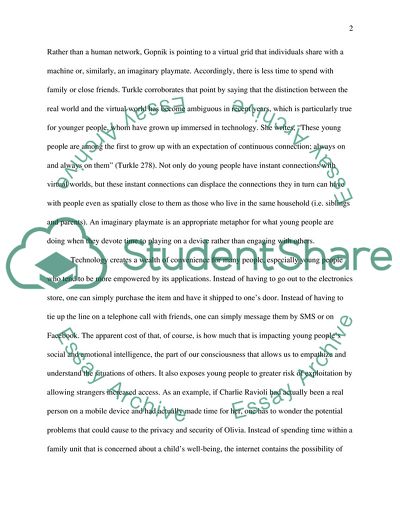Cite this document
(Transition to De-Personalized Virtual Interactions as an Amoral Process Case Study Example | Topics and Well Written Essays - 1500 words, n.d.)
Transition to De-Personalized Virtual Interactions as an Amoral Process Case Study Example | Topics and Well Written Essays - 1500 words. https://studentshare.org/sociology/1862706-to-what-extent-does-technology-represent-a-hindrance-to-human-connection-or-does-it-represent-a-hindrance-at-all-or-might-technology-present-a-new-dimension-of-human-connection-and-intimacy
Transition to De-Personalized Virtual Interactions as an Amoral Process Case Study Example | Topics and Well Written Essays - 1500 words. https://studentshare.org/sociology/1862706-to-what-extent-does-technology-represent-a-hindrance-to-human-connection-or-does-it-represent-a-hindrance-at-all-or-might-technology-present-a-new-dimension-of-human-connection-and-intimacy
(Transition to De-Personalized Virtual Interactions As an Amoral Process Case Study Example | Topics and Well Written Essays - 1500 Words)
Transition to De-Personalized Virtual Interactions As an Amoral Process Case Study Example | Topics and Well Written Essays - 1500 Words. https://studentshare.org/sociology/1862706-to-what-extent-does-technology-represent-a-hindrance-to-human-connection-or-does-it-represent-a-hindrance-at-all-or-might-technology-present-a-new-dimension-of-human-connection-and-intimacy.
Transition to De-Personalized Virtual Interactions As an Amoral Process Case Study Example | Topics and Well Written Essays - 1500 Words. https://studentshare.org/sociology/1862706-to-what-extent-does-technology-represent-a-hindrance-to-human-connection-or-does-it-represent-a-hindrance-at-all-or-might-technology-present-a-new-dimension-of-human-connection-and-intimacy.
“Transition to De-Personalized Virtual Interactions As an Amoral Process Case Study Example | Topics and Well Written Essays - 1500 Words”. https://studentshare.org/sociology/1862706-to-what-extent-does-technology-represent-a-hindrance-to-human-connection-or-does-it-represent-a-hindrance-at-all-or-might-technology-present-a-new-dimension-of-human-connection-and-intimacy.


